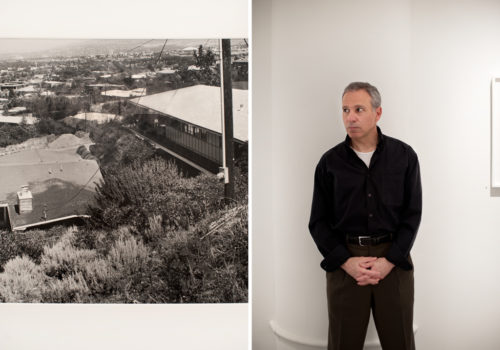Day 9
Leaving Robert Mann’s gallery, I order a soda at the old Empire Diner. It’s a mythical place. My friends and I would usually end up here after the regular Thursday night exhibition openings—hungry and maybe a little tipsy too.
I have just enough time to prepare myself for the next gallerist, Rick Wester. Just enough time to prepare my questions about his current exhibition, D.W. Mellor’s Garvey: 30 Years, A Photographic Portrait.
Yet another incredible story. I’m fascinated by tales like this: During a commercial shoot in Pennsylvania, the photographer D.W. Mellor sees an unlikely character cruise by on a Harley. This is Garvey. He works as a technical inspector for Boeing but has chosen to live in isolation, not so much from other people as from the modern world. His modesty and simplicity impressed Mellor, who came back annually over for the next thirty years to photograph him. They became friends.
Rick Wester is exhibiting these three decades of portraits. I rush to the gallery to take in these strange images. They’re tender, but with a certain rawness too. Rick enters holding the Joe Deal print he’s chosen to show me. For the first time since the beginning of this project, I’m surprised. Even for a third-generation art dealer like Rick, the choice is daring. His peers have chosen more celebrated and historical photographs by the likes of Ansel Adams and Robert Frank.
Rick explains that he immediately fell for Deal’s rebellious and unconventional style—how he chose to photograph urban landscapes instead of the countryside, using a low-contrast exposure to highlight the city’s disaffection. A feeling of emptiness and distress pervades these photographs, which was very radical for the time. We lost ourselves in this fascinating discussion. I only had time to ask two quick questions about Garvey, as I was leaving: “Has Garvey come to see the exhibition?” “No.” “Where is he?” “No one knows, not even Mellor.” I definitely love stories like this. Thank you, Rick.
From his first encounter with photography to the opening of his own
gallery …
Rick tells me how he grew up “in” art. His European father was an art dealer who sold Old Master prints and drawings. Rick remembers framing works by Dürer and Rembrandt when he was 10 years old.
He also remembers quite well the moment he fell for photography. At the time, he was at college in Westchester, where there was a free magazine. The editors published a series of photographs by Emmet Gowin: not only portraits of his family and wife, but a few nudes as well. Rick says that these images fascinated him.
It was then that he enrolled in art classes, going on to earn a degree in fine arts and photography.
At 24 he began buying and selling prints, joining Christie’s in 1992. He would stay there for nine years. Rick remembers it as the best job he ever had, in terms of how much he learned and how much success he had.
In 2001, he spent a year at the Gagosian Gallery before leaving to work for himself again. He started consulting for the Philip de Pury & Co. auction house, where he makes some of his biggest sales, among them works by Vik Muniz, Robert Adams, Lee Friedlander, Philip-Lorca diCorcia and Garry Winogrand.
Rick opened his own gallery in 2007 and brings on Sara Stout, a former colleague of Howard Greenberg, as a partner. He says that he might not have opened his gallery at the right time—but he did it, and had wanted to for quite a while.
His best memory as a gallerist…
The reception his gallery hosted for Meghan Boody’s The Lighthouse Project.
At the time, her photographic montages depicted children that looked like they had walked out of some creepy fairy tale. They were more disturbing than intriguing. Rick remembers the size of the crowd that night in the packed gallery, and finally realizing that he had opened a public space. He ends by saying since that exhibition, Boody’s work has been more highly regarded and more actively sought by collectors.
His worst memory as a gallerist…
It’s not so much a single memory but a sad realization. Rick explains that the recession, the internet and the explosion of the photography market have all had one very painful consequence: the disappearance of the unhurried “artistic stroll” that brought passersby, baffled collectors and photography lovers into the galleries… He misses the days when people would take their time, would know the artists they were coming to see, would ask to know more, would get engaged in a conversation…
He also says that the advent of digital technology has completely changed our way of looking at an image, especially for the young. It pains him that students of art and aesthetics now learn through the screen and not books.
The first photograph he bought for himself? Or one that has a special
importance in his life…
View, Salt Lake City, Utah, 1977 by Joe Deal
On his bedroom wall…
Sally Weld County by Robert Adams.
It was a gift from the photographer to thank Rick for selling his pictures at a time when no one was interested in buying them.
If he was a renowned photographer…
He hesitates. The only photographers he admires led rather unhappy lives.
He chooses John Williams Draper. A friend of Samuel Morse, Draper isn’t well known as a photographer, but he was the first to photograph a human face in detail. His wife sat unmoving for five hours while he took her portrait. He was also the first person to photograph the moon. Rick adds that he feels a particular attachment to Draper because they were born in the same place.
















